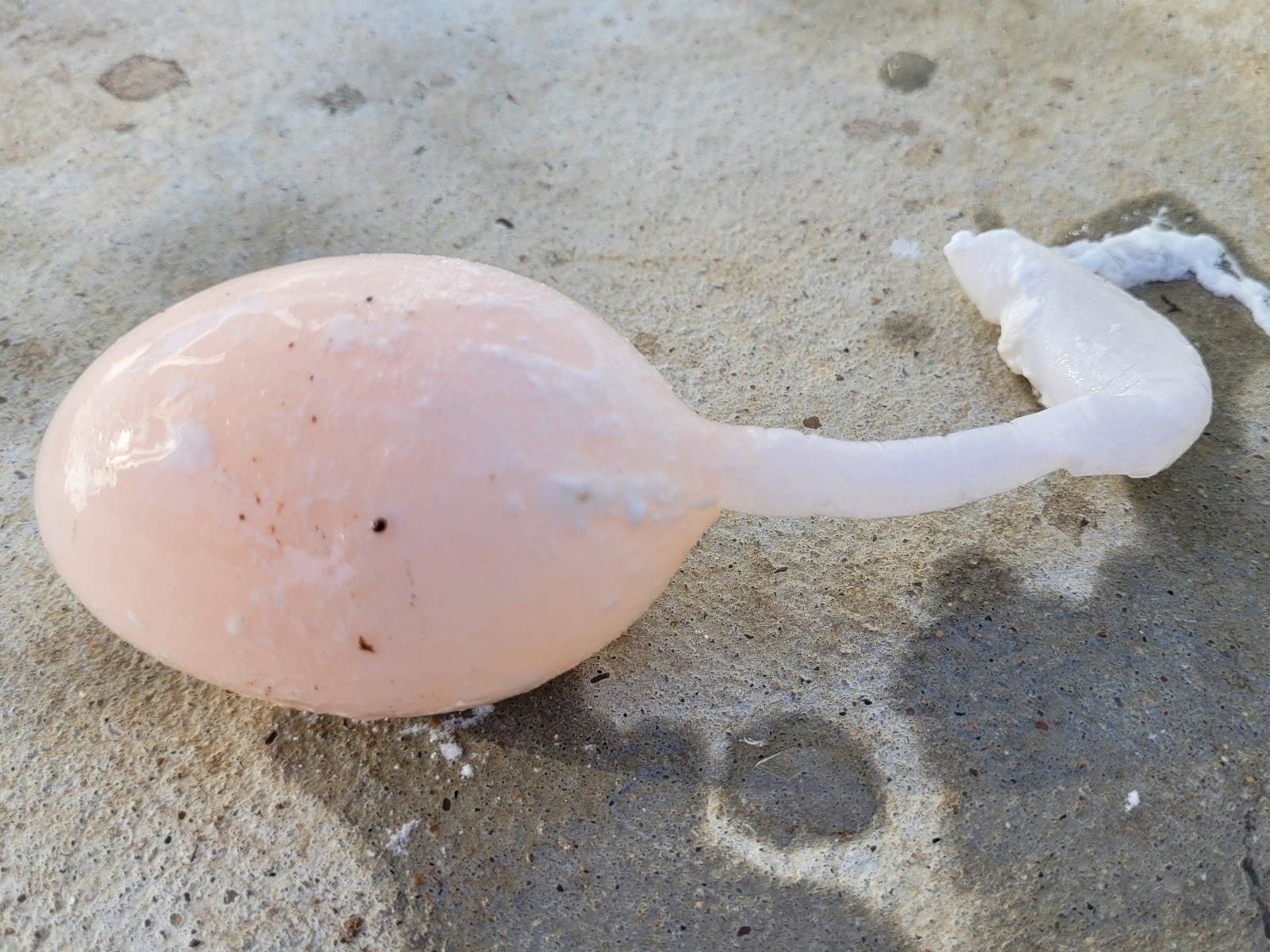
Soft-Shelled Eggs in Ducks – Everything You Need to Know
Last updated on July 16th, 2024 at 06:32 pm
Ever wondered why your duck might be laying soft-shelled eggs? Or maybe you’ve dealt with the worry of how dangerous this is for your duck. Don’t worry – it’s a common issue! In this post, we’re diving into the nitty-gritty of soft-shelled eggs: why they happen, how to prevent them, and what to do if they occur. Let’s explore the reasons behind this egg-laying puzzle and find practical ways to keep our ducks healthy and happy. Join us as we unravel the mysteries of duck egg production! 🦆🥚
If you want to read what happened to our Duck Schnatterinchen and how we helped her, read our blog post: How We Saved Our Egg-Bound Duck (Case Study)
If your duck is egg-bound, you need to act fast! Egg-bound ducks can die within 24-48 hours!
This article is part of our Duck Health Conditions Series.
Disclaimer: I may earn a commission if you purchase products or services through my affiliate links. This does not affect the price you pay. I only recommend products and services that I believe in and that I think will be helpful to my readers.
How are eggs formed?
The first step in understanding soft-shelled eggs is to know how eggs are formed in ducks.
Ducks are known for their prolific egg-laying abilities, with some species capable of producing hundreds of eggs per year. But how exactly do ducks lay eggs? Here, we’ll explore the biology behind duck egg production and the process of egg laying.
Duck egg production begins with ovulation. Like all birds, ducks have a reproductive system consisting of ovaries and oviducts, where eggs are formed and then transported to the outside of the body. The ovary ovulates the yolk, which is released into the oviduct. The yolk travels through the oviduct, where sperm from the male duck may fertilize it if the duck is in breeding condition.
Once the yolk is released from the follicles, it moves through the oviduct, where it is coated with layers of albumen or egg white. The shell membrane is deposited in the isthmus before the hard, protective shell is formed. The shell gland calcifies the egg over about 20 hours, depositing calcium carbonate after a layer of hard albumen is formed around the egg. Once the egg is fully formed, it is laid. Ducks typically lay one egg per day. An egg formation process typically takes around 24 hours for a duck egg.
The following video displays this process very nicely. While this video explains the process of egg development in chickens, it is still very informative, as the process in ducks is very similar.
What Exactly Are Soft-Shelled Eggs?
Soft-shelled eggs in ducks can be a frustrating and mysterious problem for duck owners. These eggs have a thin, rubbery shell that is easily cracked or broken, and they can be difficult to handle and transport. They almost feel like bouncy balls. It is also difficult for your duck to pass and lay soft-shelled eggs properly because they cause more friction. This is why you sometimes see that your duck is egg-bound with soft-shelled eggs.
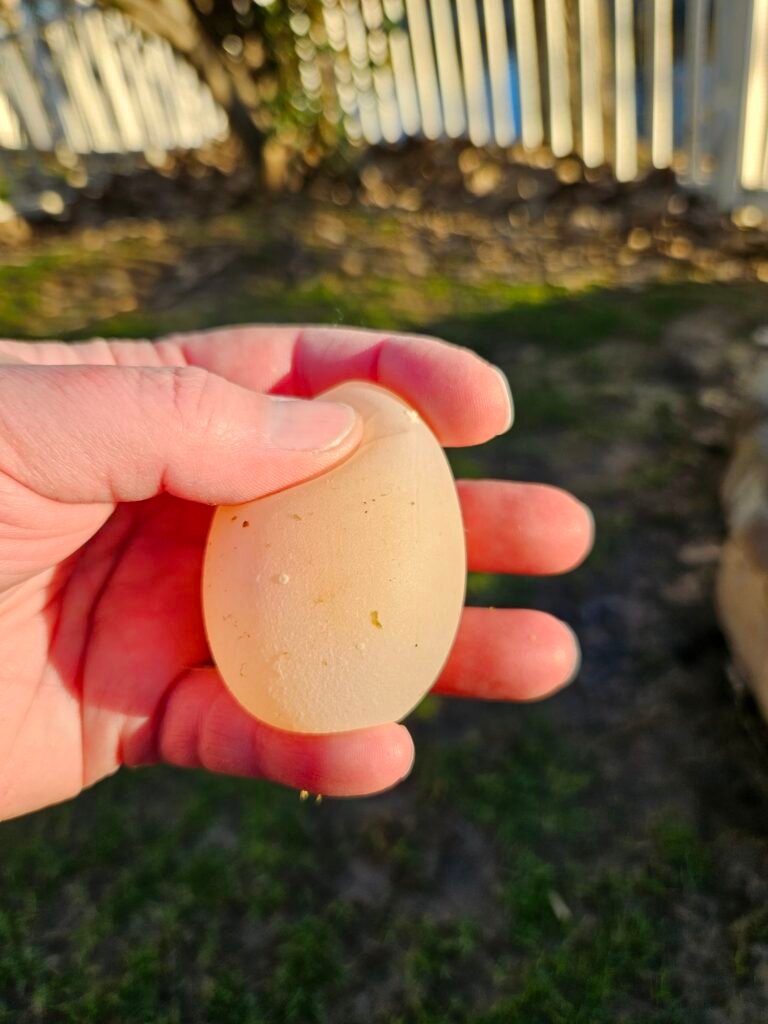
What are the Reasons for Soft-Shelled Eggs?
Premature Young Ducks
When ducks are young and still developing, their reproductive systems might not be fully matured. This immaturity can initially lead to the production of soft-shelled eggs. We observed this phenomenon firsthand with two of our beloved ducks, Hertha and Krümel.
As fledglings, they each laid a soft-shelled egg as their very first, likely because their bodies were not yet fully prepared for egg-laying. However, as they continued to grow and mature, their reproductive systems caught up, and they began laying normal eggs shortly thereafter. It’s a natural part of their development process, and with time, most ducks outgrow this early hiccup and go on to lay healthy, sturdy eggs.
Calcium Deficiency Can Be Detrimental
One of the most common causes of soft-shelled eggs is a lack of calcium in the duck’s diet. Ducks need a sufficient amount of calcium to produce strong, healthy eggshells. We have learned above, the egg-shell is formed in the shell gland, where the egg is calcified over a period of about 20 hours. The shells will be thin and weak without enough calcium, resulting in soft-shelled eggs.
1. Eggshell Formation: Ducks primarily utilize calcium in the formation of eggshells. During the egg-laying process, calcium is mobilized from the duck’s bones and circulated to the reproductive system, where it is deposited in the developing eggshell. Adequate levels of calcium are crucial for producing eggshells that can withstand environmental pressures and provide adequate protection to the developing embryo.
2. Dietary Requirements: Ducks obtain calcium from their diet, making it essential to provide them with a balanced and nutritious feed. Commercial duck feeds often contain added calcium to meet the dietary requirements of laying hens. Additionally, ducks may supplement their diet with calcium-rich foods such as leafy greens, eggshells, or crushed oyster shells, which serve as valuable sources of supplemental calcium.
3. Calcium Metabolism: Proper calcium metabolism is essential for ensuring that ducks effectively utilize calcium for eggshell formation. Vitamin D plays a critical role in calcium absorption, helping ducks absorb calcium from their diet and transport it to the reproductive system. Adequate levels of vitamin D are necessary to support optimal calcium metabolism and eggshell quality in ducks.
4. Reproductive Health: Calcium deficiencies can have significant implications for duck reproductive health. Inadequate calcium levels may lead to the production of soft-shelled eggs or even the development of egg binding, a condition where eggs become stuck in the reproductive tract. Ensuring that ducks receive sufficient calcium promotes reproductive health and prevents complications during the egg-laying process.
5. Overall Health Benefits: Beyond eggshell formation, calcium is essential for maintaining overall duck health. Calcium plays a crucial role in bone development and muscle function, contributing to the structural integrity and mobility of ducks. Ensuring that ducks receive adequate calcium is vital for promoting strong bones, healthy egg production, and overall well-being.
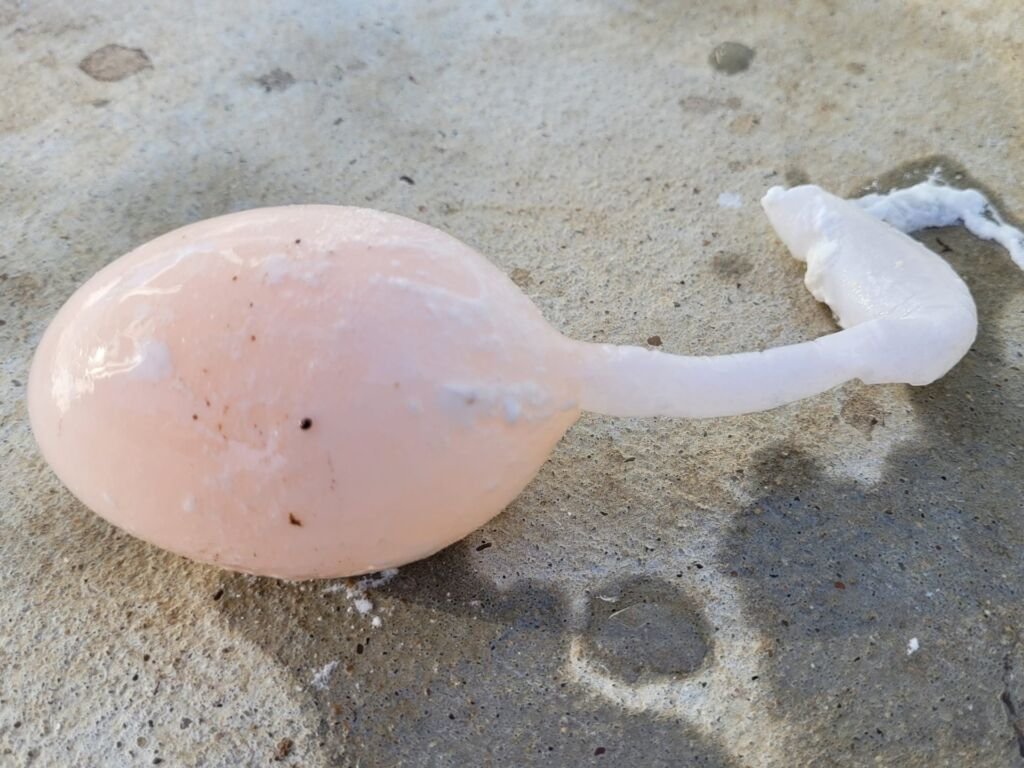
Vitamin D Deficiency: The Sunshine Vitamin is Essential for Strong Eggshells
Vitamin D plays a crucial role in ducks’ health, particularly in forming strong eggshells. Ducks, like humans and many other animals, rely on vitamin D for various physiological processes, including calcium absorption and bone health.
1. Calcium Absorption: Vitamin D facilitates the absorption of calcium from the duck’s diet into the bloodstream. Calcium is a vital mineral required for the formation of eggshells. Without sufficient vitamin D, ducks may struggle to absorb an adequate amount of calcium, leading to deficiencies that result in soft-shelled eggs.
2. Eggshell Formation: Once absorbed, calcium is transported to the reproductive system, where it is utilized in the formation of eggshells. Vitamin D ensures that calcium is effectively utilized by the body, contributing to the development of sturdy eggshells that protect the developing embryo.
3. Sunlight Synthesis: Ducks can naturally synthesize vitamin D through exposure to sunlight. When ducks bask in sunlight, their skin absorbs ultraviolet B (UVB) rays, which trigger the production of vitamin D in the body. Adequate exposure to sunlight is essential for maintaining optimal vitamin D levels in ducks and promoting healthy eggshell production.
4. Dietary Sources: While sunlight exposure is the primary source of vitamin D for ducks, they can also obtain it from their diet. Commercial duck feeds may be fortified with vitamin D to ensure that ducks receive sufficient levels of this essential nutrient. Additionally, ducks may consume vitamin D-rich foods such as certain types of fish or fortified supplements.
5. Impact of Deficiency: A vitamin D deficiency can have detrimental effects on eggshell quality and overall duck health. Ducks lacking adequate vitamin D may experience difficulties forming strong eggshells, resulting in an increased prevalence of soft-shelled eggs. Moreover, vitamin D deficiency can contribute to skeletal abnormalities and weakened immune function in ducks.
By understanding the importance of vitamin D in eggshell formation, you can take proactive measures to ensure that your ducks receive adequate sunlight exposure, dietary supplementation, and overall care to support optimal eggshell quality and duck health.
Other Essential Minerals Responsible for Duck Egg Formation
In addition to calcium, there are several other essential minerals that play important roles in duck health and egg production. Let’s explore some of these key minerals:
1. Phosphorus: Phosphorus is essential for bone formation, energy metabolism, and the utilization of other nutrients in ducks. It works closely with calcium in the formation of bones and eggshells, contributing to skeletal strength and eggshell quality.
2. Magnesium: Magnesium is involved in numerous physiological processes in ducks, including muscle function, nerve transmission, and energy metabolism. It also plays a role in calcium absorption and utilization, indirectly influencing eggshell formation and overall duck health.
3. Potassium: Potassium is important for maintaining fluid balance, nerve function, and muscle contractions in ducks. It helps regulate heart rhythm and supports proper digestion and nutrient absorption, contributing to overall health and vitality in ducks.
4. Sodium: Sodium is necessary for maintaining fluid balance, nerve function, and muscle contractions in ducks. It is also involved in regulating blood pressure and pH balance, ensuring optimal physiological functioning and performance.
5. Iron: Iron is essential for the production of hemoglobin, the protein responsible for transporting oxygen in the blood. It plays a critical role in oxygen delivery to tissues and cells, supporting metabolism, growth, and overall vitality in ducks.
6. Zinc: Zinc is involved in various enzymatic reactions and cellular processes in ducks, including protein synthesis, immune function, and wound healing. It also plays a role in reproductive health and hormone regulation, influencing egg production and fertility.
7. Copper: Copper is necessary for the formation of red blood cells, connective tissues, and enzymes involved in metabolism and antioxidant defense. It supports immune function, bone development, and iron utilization, contributing to overall health and vitality in ducks.
8. Manganese: Manganese is involved in bone formation, cartilage development, and enzyme activation in ducks. It plays a role in reproductive health, eggshell formation, and the metabolism of carbohydrates, fats, and proteins.
9. Selenium: Selenium is a vital antioxidant that protects cells from oxidative damage and supports immune function in ducks. It is also involved in thyroid hormone metabolism and reproductive health, influencing egg production and fertility.
Ensuring that ducks receive a balanced diet containing adequate levels of these essential minerals is essential for promoting overall health, vitality, and optimal egg production. To meet the nutritional needs of their feathered companions, you should provide a diverse range of nutrient-rich foods, including commercial feeds, fresh greens, and supplements. Regular monitoring of duck health and consulting with a veterinarian can help identify any deficiencies or imbalances and ensure appropriate dietary adjustments to support optimal duck health and egg production.
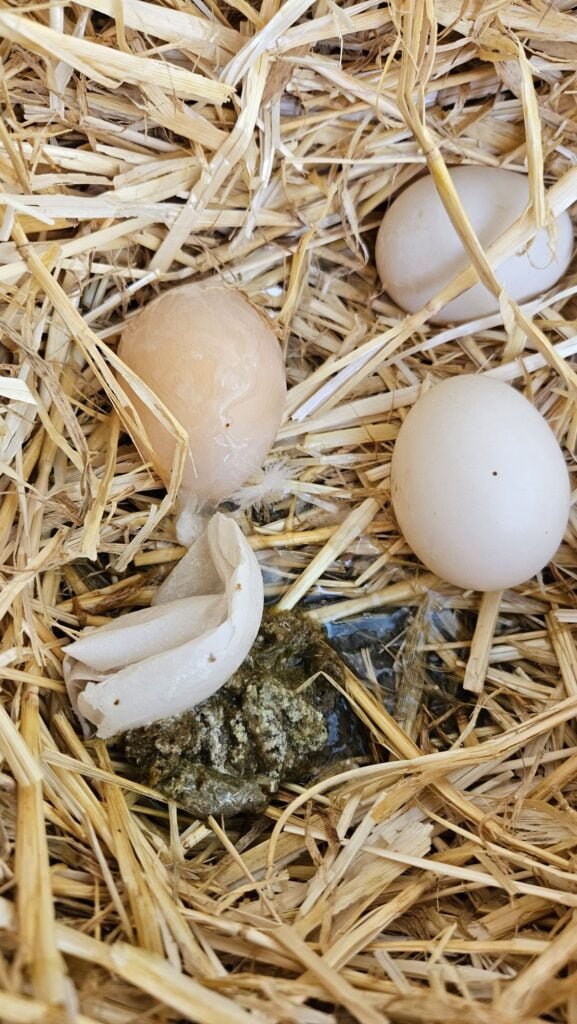
Hormonal Imbalance: The Hidden Influence on Duck Health and Egg Production
Hormones play a crucial role in regulating various physiological processes in ducks, including reproduction and egg-laying. When hormonal balance is disrupted, it can lead to a range of issues affecting duck health and egg production.
1. Reproductive Hormones: Ducks rely on a delicate balance of reproductive hormones, including estrogen and progesterone, to regulate their reproductive cycles. Any disruptions to these hormones, such as fluctuations in hormone levels or abnormalities in hormone production, can impact egg production and quality.
2. Stress Response: Stress can trigger hormonal imbalances in ducks, affecting their reproductive health and egg-laying patterns. Environmental stressors, such as noise, predators, or changes in routine, can induce the release of stress hormones like cortisol, which may interfere with the normal functioning of the reproductive system.
3. Seasonal Changes: Hormonal fluctuations in response to seasonal changes can influence egg production in ducks. For example, decreased daylight hours in winter can suppress the release of reproductive hormones, leading to a decrease in egg-laying frequency. Conversely, longer daylight hours in spring can stimulate hormone production and increase egg production.
4. Thyroid Function: The thyroid gland plays a crucial role in regulating metabolism and hormone production in ducks. Thyroid disorders, such as hypothyroidism or hyperthyroidism, can disrupt hormone levels and impact reproductive health. Thyroid imbalances may manifest as changes in egg production, eggshell quality, or overall fertility in ducks.
5. Dietary Factors: Nutritional imbalances can also contribute to hormonal disruptions in ducks. Inadequate levels of essential nutrients, such as protein, vitamins, and minerals, can affect hormone synthesis and metabolism. Additionally, certain dietary components, such as phytoestrogens or mycotoxins, may mimic or interfere with natural hormones, leading to hormonal imbalances.
6. Age and Reproductive Status: Hormonal imbalances may occur naturally as ducks age or transition through different reproductive stages. For example, older ducks may experience changes in hormone production, leading to decreased fertility or irregular egg-laying patterns. Similarly, hormonal fluctuations during molting or brooding periods can affect egg production in ducks.
Understanding the potential impact of hormonal imbalance on duck health and egg production is crucial for duck parents. By identifying and addressing underlying factors contributing to hormonal disruptions, such as stress, diet, or environmental conditions, you can promote optimal hormone balance and support healthy egg-laying behavior in your feathered companions. Additionally, consulting with a veterinarian experienced in avian health can provide valuable insights and guidance for managing hormonal imbalances in ducks.
Understanding Reproductive Factors Contributing to Soft-Shelled Eggs in Ducks
Reproductive issues can significantly contribute to the occurrence of soft-shelled eggs in ducks. When ducks experience disruptions in their reproductive physiology, it can lead to abnormalities in eggshell formation and quality. Here’s how reproductive issues can cause soft-shelled eggs:
- Hormonal Imbalances: Hormonal regulation plays a crucial role in the reproductive cycle of ducks, including the development and maturation of eggs. Disruptions in hormone levels, such as fluctuations in estrogen or progesterone, can affect the functioning of the reproductive tract and the deposition of calcium in the eggshell. Hormonal imbalances may result from genetic factors, environmental stressors, or underlying health conditions affecting the endocrine system.
- Ovulatory Dysfunction: Ducks experiencing ovulatory dysfunction may produce eggs with irregular shell formation or incomplete calcification. Ovulatory dysfunction can be caused by factors such as inadequate follicular development, follicular cysts, or impaired ovulation. Eggs laid by ducks with ovulatory dysfunction may exhibit abnormalities in shell texture, thickness, or integrity, contributing to the production of soft-shelled eggs.
- Reproductive Tract Disorders: Disorders affecting the reproductive tract, such as inflammation, infection, or structural abnormalities, can interfere with eggshell formation in ducks. Inflammation or infection of the oviduct can disrupt the normal processes of eggshell deposition and mineralization, leading to the production of soft-shelled eggs. Structural abnormalities, such as tumors or cysts, may obstruct the passage of eggs through the oviduct, resulting in abnormal eggshell formation or retention.
- Stress-induced Reproductive Suppression: Prolonged or severe stress can suppress ducks’ reproductive function, leading to disruptions in egg production and shell quality. Stress-induced changes in hormone levels, such as elevated cortisol or adrenaline, can interfere with ovulation, shell gland function, and eggshell formation. Ducks experiencing chronic stress may exhibit irregularities in egg production, including the production of soft-shelled eggs.
- Age-related Changes: Ducks may experience changes in reproductive function as they age, including alterations in hormone levels and ovarian activity. Older ducks may exhibit declines in egg production and shell quality as their reproductive systems age. Age-related changes in hormone levels or reproductive tract function can contribute to abnormalities in eggshell formation and increase the likelihood of producing soft-shelled eggs.
Genetics and Soft-Shelled Eggs
Genetics plays a significant role in determining the likelihood of ducks laying soft-shelled eggs, a concern that affects both productivity and the birds’ health. Understanding the genetic factors behind this occurrence is crucial for breeders and duck enthusiasts alike.
1. Breed Predisposition: Certain duck breeds are more prone to laying soft-shelled eggs due to genetic predispositions. For instance, some heritage breeds, such as the Indian Runner or Khaki Campbell, may exhibit a higher incidence of soft-shelled eggs compared to other breeds. These predispositions are often linked to the respective breeds’ genetic background and breeding history.
2. Genetic Variability: Significant genetic variability can influence the occurrence of soft-shelled eggs within a breed. Breeding practices aimed at selecting for specific traits, such as egg production or body size, may inadvertently affect the genetic factors related to eggshell quality. Breeders must carefully manage genetic diversity and selection criteria to minimize the risk of soft-shelled eggs in their breeding stock.
3. Calcium Metabolism Genes: Genes involved in calcium metabolism play a crucial role in eggshell formation and quality. Variations in these genes can affect the duck’s ability to absorb and utilize calcium, leading to deficiencies and the production of soft-shelled eggs. Understanding the genetic basis of calcium metabolism can help breeders identify individuals with optimal calcium utilization and reduce the incidence of soft-shelled eggs in their flock.
4. Hormonal Regulation: Genetic factors also influence ducks’ hormonal regulation, which impacts egg production and shell quality. Variations in genes related to hormone synthesis, secretion, or receptor sensitivity may contribute to hormonal imbalances predisposing ducks to lay soft-shelled eggs. Breeding programs focused on optimizing hormonal regulation can help mitigate this risk.
5. Hybridization Effects: Crossbreeding or hybridization between different duck breeds can sometimes influence eggshell quality. While hybrid vigor may confer advantages in certain traits, it can also introduce genetic interactions that affect calcium metabolism, shell formation, and egg quality. Breeders should carefully monitor hybrid crosses to assess their impact on soft-shelled egg incidence.

Egg Drop Syndrome (EDS): Understanding its Impact on Duck Health and Egg Production
Egg Drop Syndrome (EDS) is a viral disease that primarily affects poultry, including ducks, and can have significant implications for egg production and flock health. The disease is caused by the Egg Drop Syndrome virus (EDSV), which belongs to the family Adenoviridae. EDSV primarily targets the reproductive organs of ducks, leading to a decline in egg production and quality.
1. Transmission: EDSV is highly contagious and can spread rapidly within duck populations through direct contact with infected birds, contaminated equipment, or the environment. Infected ducks shed the virus in their feces, saliva, and respiratory secretions, facilitating transmission to susceptible individuals within the flock.
2. Clinical Signs: Ducks infected with EDS may exhibit a range of clinical signs, including a sudden drop in egg production, soft-shelled or misshapen eggs, and reproductive tract abnormalities. Other signs may include lethargy, decreased appetite, and increased mortality in severe cases. It’s important to note that not all infected ducks will display clinical signs, making early detection and diagnosis challenging.
3. Impact on Egg Production: One of the hallmark effects of EDS is a significant reduction in egg production, often referred to as an “egg drop.” Infected ducks may experience a sharp decline in egg production, with some individuals ceasing to lay eggs altogether. The quality of eggs laid during an EDS outbreak may also be compromised, with a higher incidence of soft-shelled eggs, shell abnormalities, or decreased hatchability.
4. Pathogenesis: EDSV primarily targets the oviduct and reproductive organs of ducks, disrupting normal egg formation and shell quality. The virus infects and damages the oviduct’s epithelial cells, leading to eggshell formation and calcium metabolism alterations. This disruption in egg production can have significant economic consequences for duck producers, resulting in decreased profitability and potential losses.
5. Diagnosis and Control: Diagnosing EDS in ducks typically involves a combination of clinical evaluation, laboratory testing, and serological analysis. Control and prevention strategies may include biosecurity measures, vaccination programs, and management practices aimed at reducing the risk of viral transmission within duck populations. Vaccination against EDSV can help protect susceptible ducks and minimize the impact of outbreaks on egg production and flock health.
Overall, Egg Drop Syndrome poses a significant challenge for duck producers, with its potential to cause substantial losses in egg production.
Stress: The Silent Culprit Behind Soft-Shelled Eggs
Stress is a common yet often overlooked factor that can profoundly affect eggshell quality in ducks. Ducks, like all animals, are sensitive creatures, and stressors in their environment can disrupt their reproductive physiology, leading to the production of soft-shelled eggs. Understanding the role of stress and implementing strategies to mitigate its effects is crucial for maintaining optimal eggshell quality and duck health.
1. Physiological Response: When ducks experience stress, whether from environmental factors, social dynamics, or handling procedures, their bodies undergo a cascade of physiological responses. Stress triggers the release of hormones such as cortisol and adrenaline, which prepare the duck for a “fight or flight” response. While these responses are adaptive in the short term, chronic or excessive stress can have detrimental effects on the reproductive system.
2. Reproductive Suppression: Prolonged or severe stress can suppress ducks’ reproductive functions, disrupting the delicate balance of hormones involved in egg production. Stress-induced changes in hormone levels can impair ovulation, disrupt eggshell formation, and reduce the frequency and quality of eggs laid by affected ducks. This can manifest as a higher incidence of soft-shelled eggs or a decline in egg production overall.
3. Impact on Eggshell Formation: Stress can directly affect eggshell formation in ducks by disrupting the deposition of calcium and other minerals in the shell gland of the reproductive tract. Stress-induced changes in blood flow, hormone levels, and nutrient utilization can impair eggshell development, resulting in abnormalities such as thin shells, shell deformities, or incomplete calcification.
4. Environmental Stressors: Ducks may encounter a variety of environmental stressors that can impact eggshell quality. These stressors include loud noises, abrupt changes in temperature or lighting, overcrowding, predator presence, and disturbances to their nesting or foraging areas. Additionally, transportation, handling, or other management practices can induce stress in ducks, affecting their reproductive health and egg production.
5. Management Strategies: To minimize the impact of stress on eggshell quality, duck enthusiasts should implement management strategies aimed at reducing environmental stressors and promoting a calm, supportive environment for their flock. Providing adequate space, comfortable housing, and access to natural behaviors such as swimming and foraging can help reduce stress levels in ducks. Maintaining consistent routines, minimizing disturbances, and gently handling ducks can contribute to their overall well-being and reproductive success.
What are the Symptoms of Soft-Shelled Eggs?
We have already mentioned several of the symptoms throughout this post. Still, I wanted to summarize them here so that you can quickly identify if your duck may suffer from being egg-bound (or has trouble passing a soft-shelled egg).
- Thin, Flexible Shells: Soft-shelled eggs lack normal eggs’ usual hardness and rigidity. Instead, they may have thin, pliable shells that are easily deformed or broken.
- Misshapen Eggs: Soft-shelled eggs may have irregular shapes or sizes compared to normal eggs. They may appear lumpy, wrinkled, or uneven in texture.
- Abnormal Egg Color: Soft-shelled eggs may exhibit unusual colors or pigmentation, ranging from pale or translucent to discolored or streaked. These abnormalities may indicate disruptions in the eggshell formation process.
- Egg Breakage: Soft-shelled eggs are more fragile and prone to breakage compared to normal eggs. Ducks may accidentally break soft-shelled eggs while laying or handling them, resulting in a messy, yolky discharge.
- Decreased Eggshell Integrity: Soft-shelled eggs may lack the structural integrity needed to protect the developing embryo. Ducks may lay soft-shelled eggs with cracked or porous shells, increasing the risk of contamination and reduced hatchability.
- Reduced Egg Production: Ducks experiencing issues with soft-shelled eggs may exhibit a decline in egg production or irregular laying patterns. Soft-shelled eggs may be laid less frequently or intermittently compared to normal eggs.
- Nesting Behavior Changes: Ducks affected by soft-shelled eggs may exhibit alterations in nesting behavior, such as spending more time in the nest or showing signs of discomfort or distress during egg-laying.
Physical Symptoms:
In severe cases, ducks experiencing complications related to soft-shelled eggs may display physical symptoms such as lethargy, weakness, or reluctance to move. These symptoms may indicate underlying health issues requiring veterinary attention. Below is a list of common symptoms:
- Loss of appetite.
- Lethargic, sitting around.
- ‘looks sick,’ depressed.
- Shaky wings.
- She walks like a penguin – she will periodically stop walking and try to squat.
- She may be limping because the egg presses on a nerve.
- Abdominal straining – you can see the cloaca (vent) straining to expel something.
- Tail pumping – her tail will pump up and down to expel the egg.
- She may just sit inside the water without splashing around.
- You may be able to feel the egg when examining her.
It’s essential for duck keepers to monitor their flock closely for signs of soft-shelled eggs and address any underlying factors contributing to this condition. Providing a balanced diet, ensuring optimal environmental conditions, and practicing good husbandry can help support healthy egg production and minimize the occurrence of soft-shelled eggs in ducks. If soft-shelled eggs persist or are accompanied by other concerning symptoms, consulting with a veterinarian experienced in avian health is recommended for proper diagnosis and treatment.
How to Prevent Soft-Shelled Eggs in Ducks?
Monitor Your Ducks
To prevent soft-shelled eggs, it’s essential to keep a close eye on your ducks and their eggs. If you notice that your ducks are laying soft-shelled eggs, make sure to address the cause as soon as possible. If you’re unsure of the cause, a veterinarian can help you diagnose the problem and recommend a course of treatment.
- Nutritional Management: Ensure that ducks receive a balanced diet formulated specifically for laying hens. A diet rich in calcium, phosphorus, vitamin D, and other essential nutrients is crucial for promoting optimal eggshell quality and preventing deficiencies that can lead to soft-shelled eggs.
- Supplementation: Provide supplemental sources of calcium, such as crushed oyster shells or commercially available calcium supplements, to support eggshell formation in ducks. Offer these supplements free-choice to ensure ducks have access to additional calcium as needed.
- Environmental Considerations: Create a stress-free environment for ducks by minimizing disturbances, providing ample space, and maintaining stable temperature and lighting conditions. Reduce overcrowding, noise, and other stressors that can disrupt egg production and shell quality.
- Hydration: Ensure ducks have access to clean, fresh water at all times. Proper hydration is essential for supporting egg production and shell formation in ducks. Monitor water quality and availability to prevent dehydration and its adverse effects on egg quality.
- Health Monitoring: Regularly monitor the health and behavior of ducks for signs of stress, illness, or reproductive issues. Implement a health management program that includes routine veterinary check-ups, parasite control, and vaccination against common poultry diseases.
How Treat Soft-Shelled Eggs in Ducks?
The treatment may look different depending on the underlying cause. We are not professionals, and the following tips are based on our own experience. Please see a vet to check your duck if you are experiencing serious issues. The vet must prescribe some medication.
In General, you should implement the following:
- Dietary Adjustments: If soft-shelled eggs occur due to nutritional deficiencies, adjust the duck’s diet to ensure they receive adequate levels of essential nutrients, particularly calcium and vitamin D. Increase the availability of calcium-rich foods or supplements to support eggshell formation.
- Environmental Modifications: Address any environmental stressors or management practices that may be contributing to soft-shelled eggs. Provide a comfortable nesting area, minimize disturbances during egg-laying, and optimize the nesting substrate to promote eggshell integrity.
- Supplementation: Offer additional sources of calcium, vitamin D, and other micronutrients to ducks experiencing soft-shelled eggs. Commercial supplements or natural sources such as leafy greens, eggshells, or seafood can help boost nutrient intake and support eggshell quality.
- Veterinary Consultation: If soft-shelled eggs persist despite dietary and environmental interventions, seek guidance from a veterinarian experienced in avian health. A veterinarian can perform diagnostic tests, assess the overall health of the flock, and recommend targeted treatments or medications as needed.
- Record Keeping: Keep detailed records of egg production, eggshell quality, and any observed changes in duck behavior or health. Monitoring trends over time can help identify patterns, evaluate the effectiveness of prevention and treatment measures, and guide adjustments to management practices as needed.
Commercial Duck Feeds:
Many commercial poultry feeds formulated for laying ducks contain added calcium to support eggshell formation. Choosing a high-quality layer feed with adequate levels of calcium can help ensure that ducks receive sufficient calcium in their diet.
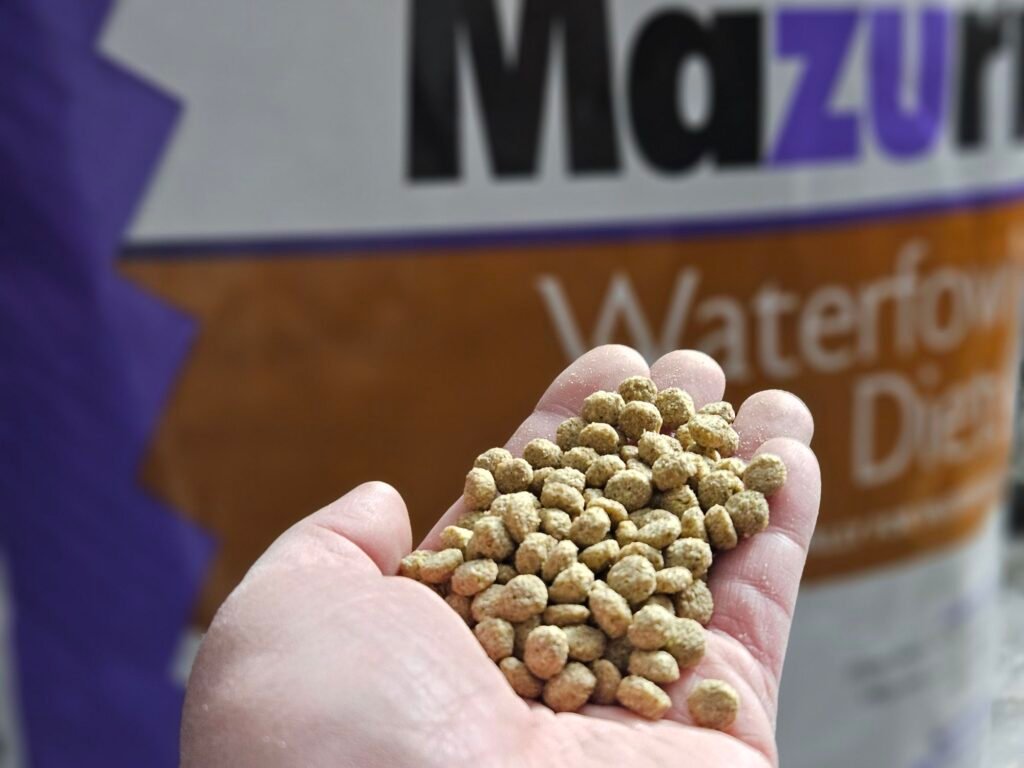
However, when considering food options for ducks, it’s important to understand the differences between maintenance and layer feed and the considerations for feeding drakes. Here’s an explanation:
Maintenance Feed: Maintenance feed is a balanced diet formulated to meet the nutritional needs of ducks during non-laying periods or for ducks not intended for egg production. It typically contains lower levels of calcium compared to layer feed since ducks in maintenance do not require as much calcium for eggshell formation. Maintenance feed provides essential nutrients to support overall health, including protein, vitamins, and minerals, while helping ducks maintain optimal body condition and energy levels.
Layer Feed: Layer feed is specifically designed for laying hens and contains higher levels of calcium to support eggshell formation. It provides the necessary nutrients to promote strong and healthy eggshells, including calcium, phosphorus, and vitamin D. However, layer feed is not suitable for ducks that are not actively laying eggs, as excess calcium intake can lead to health issues such as kidney damage and urinary tract problems. Therefore, layer feed should only be fed to ducks when they are actively laying eggs.
Consideration for Drakes: Drakes, male ducks, do not lay eggs and do not require the high levels of calcium found in layer feed. Feeding layer feed to drakes can lead to an imbalance of nutrients and potentially harmful levels of calcium in their diet. Excess calcium can cause health issues such as kidney stones and metabolic imbalances in drakes. Therefore, it’s essential to provide maintenance feed or a balanced diet specifically formulated for non-laying ducks to ensure the health and well-being of drakes.
Consideration for Mixed Flocks: In mixed flocks containing both male and female ducks, it’s essential to provide a balanced diet that meets the nutritional needs of all ducks. For female ducks (hens) that are actively laying eggs, offering maintenance feed along with free-choice access to oyster shells is recommended. Maintenance feed provides essential nutrients to support overall health in both male and female ducks, while free-choice oyster shells supplement calcium intake specifically for eggshell formation in laying hens.
Oyster shells allow female ducks to regulate their calcium intake based on their individual needs, ensuring they have access to sufficient calcium without exposing male ducks (drakes) to excess calcium levels. By providing maintenance feed and free-choice oyster shells, mixed flocks can receive appropriate dietary support to maintain the health and well-being of all ducks.
Calcium in a regular diet
As we have learned, when the duck does not have enough calcium, the hard shell can not be formed, and the egg remains soft because it only has this protein shell surrounding it. Some people also call these rubbery eggs.
Crushed Oyster Shells
Crushed oyster shells are a popular and readily available source of calcium for ducks. They provide a natural and easily digestible form of calcium that can be offered free-choice in a separate feeder for ducks to consume as needed.
Laying ducks need calcium as part of their regular diet. You can feed layer food to them or supplement them with calcium in the form of oyster shells. When you have mixed flocks, you will probably give your ducks maintenance food because the drakes do not need extra calcium. In fact, too much is harmful to them. But by giving them the free choice of oyster shell, they will usually only eat as much as they need. There are many types of oyster shells out there, from crushed, to flaked. The best are the ones that are more natural because the birds can absorb their calcium better.
Oyster Shells
Calcium plays a vital role in developing and maintaining strong bones and eggshells in ducks. As a valued Ducks of Providence community member, we’re excited to offer you an exclusive discount on Scratch and Peck Oyster Shells. Simply use code providence15 to save 15% on your first order with Scratch and Peck (the discount works for their other products as well).
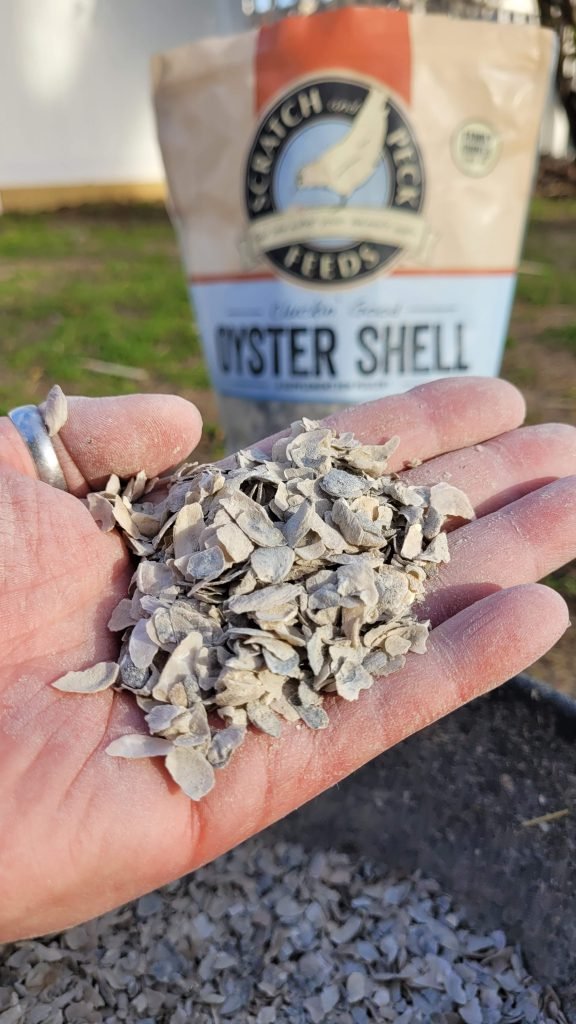
We used to use the cheaper, white ones before but had the suspicion that they were not the best for ducks. Now, we use gray oyster shell flakes. They are more natural than the other ones and have higher bioavailability of calcium.
Crushed Eggshells:
Crushed eggshells from consumed eggs can be dried, ground into a fine powder, and offered back to the ducks as a calcium supplement. This recycling method provides a natural source of calcium and helps reduce waste. Our Ducks them!
Fun Fact: Did you know that two old eggshells are used to create one new eggshell? It’s an intriguing example of nature’s efficiency at work. Eggshells, mainly composed of calcium carbonate, are recycled by ducks as they consume crushed eggshells or other sources of calcium. This calcium is then utilized to form new eggshells during the egg-laying process. Thus, the cycle continues, highlighting the natural recycling and resourcefulness inherent in egg production.
Healthy Treats
Critters. If your ducks free range, they get calcium from insects and snails. You can also feed them Grubblies (check this blog post) because they contain a healthy calcium ratio. Minnows are also a good source of calcium. Wild ducks eat small fish all the time. You can get dried minnows or feed them life ones, which you can purchase at pet stores.

Black Soldier Fly Larvae
Grubs, aka BSL (black soldier fly larvae), are rich in proteins and fats and boast significantly higher calcium content than mealworms. We’re excited to offer you an exclusive discount on Grub Terra Products. Simply use code Providence10 to save 10% on your first order with Grub Terra (the discount works for their other products as well).
Calcium Supplements
When you think your duck is not getting enough calcium with its regular diet or is already experiencing symptoms, you can give it additional calcium. Make sure to give them avian calcium. Some in powder form can be added to their food, or some in liquid forms, like Calcivet, that you can give orally.
Commercial calcium carbonate supplements explicitly designed for poultry can be purchased from feed stores or online retailers. These supplements typically come in powdered or granular form and can be mixed into the ducks’ feed according to the manufacturer’s instructions.

Our vet has prescribed Calcium Glubionate for Schnatterinchen. This is given orally through a feeding syringe (no needle). This form of calcium has good bioavailability when given in this form. I have seen in many forums that people suggest Calcium Gluconate. Our vet said this is fine, too, but only if given as an injection because its bioavailability in the digestive tract is poor.
Calcium-Rich Foods:
Certain foods naturally high in calcium can be included in the ducks’ diet to supplement their calcium intake. Examples include leafy greens (e.g., kale, collard greens), broccoli, spinach, and seaweed.
1. Leafy Greens: Leafy greens are excellent sources of calcium for ducks. Varieties such as kale, collard greens, and Swiss chard are not only rich in calcium but also provide essential vitamins and minerals necessary for overall duck health. Including a variety of leafy greens in the ducks’ diet can ensure they receive adequate calcium while adding nutritional diversity to their meals.
2. Broccoli: Broccoli is another calcium-rich vegetable that can benefit ducks. In addition to calcium, broccoli contains vitamins A, C, and K, as well as fiber and antioxidants. Feeding ducks broccoli florets stems, and leaves can provide them with a nutritious snack that supports bone health and eggshell formation.
3. Spinach: Spinach is known for its high calcium content, making it a valuable addition to ducks’ diets. However, spinach also contains oxalates, compounds that can interfere with calcium absorption. While spinach can be fed to ducks in moderation, a balanced diet that includes other calcium sources is essential to ensure optimal nutrient absorption.
4. Seaweed: Seaweed is a natural source of calcium and other minerals that can benefit ducks. It contains varying levels of calcium depending on the type of seaweed, with some varieties being particularly rich in this essential mineral. Incorporating dried seaweed or seaweed supplements into the ducks’ diet can provide them with an additional source of calcium while offering a taste of the ocean.
5. Dandelion Greens: Dandelion greens are not only abundant in many environments but also packed with calcium and other nutrients beneficial for ducks. These nutritious greens can be harvested from pesticide-free areas and offered to ducks as part of their diet. Dandelion greens provide ducks with a natural foraging experience while contributing to their calcium intake.
6. Turnip Greens: Turnip greens are another calcium-rich option for ducks. These nutrient-dense greens offer a range of vitamins and minerals, including calcium, vitamin C, and folate. Feeding ducks turnip greens can help supplement their calcium intake and provide them with a tasty and nutritious treat.
Offering a diverse range of foods not only meets the ducks’ nutritional needs but also enriches their diet, promotes natural foraging behaviors, and contributes to a happy, healthy flock.
Hormone Implants:
Hormone implants, such as Deslorelin, provide a targeted approach to addressing reproductive issues and soft-shelled egg production in ducks. Administered by a veterinarian, these implants are inserted like microchips beneath the duck’s skin, where they slowly release hormones over time. Here’s a closer look at how hormone implants work and their benefits:
How Hormone Implants Work:
- Hormone implants contain Deslorelin, a gonadotropin-releasing hormone (GnRH) drug.
- The implant is designed to remain in place beneath the duck’s skin and gradually releases Deslorelin.
- Deslorelin suppresses the production of follicle-stimulating hormone (FSH) and luteinizing hormone (LH), reducing reproductive activity in female ducks.
Benefits of Hormone Implants:
- Provides a targeted solution for ducks experiencing irregular egg-laying patterns or consistently producing soft-shelled eggs.
- Quick and easy to administer by a veterinarian.
- Effective at stopping egg production and reducing the likelihood of issues such as egg-binding.
- Typically well-tolerated by ducks, with minimal side effects.
Duration and Effectiveness:
- It may take up to 14 days for ducks to stop laying eggs after receiving the implant.
- The effects of the implant can last for a minimum of four to 8 months, depending on the size of the implant (4.7 vs. 9.4 mg).
- The duration of effectiveness may vary depending on factors such as daylight hours and seasonal changes in hormone levels.
Considerations and Side Effects:
- Hormone implants should only be administered under veterinary supervision.
- Potential side effects may include irritability and inducing a molt, but these are typically mild and temporary.
- Over time, any side effects usually wear off completely, leaving ducks happier and healthier.
In conclusion, hormone implants offer a valuable tool for managing reproductive issues in ducks, providing a safe and effective way to promote their well-being. Consulting with a veterinarian experienced in avian care is essential to determine the most appropriate treatment plan for your ducks.
Read our other article to learn more about Deslorelin (Suprelorin). We do not have much experience with hormone implants yet (we just started them with Krümel), but Dusty and Otter do. Read their success story if you want to learn more about how this works.
Other Considerations
When you think your duck is getting enough calcium but still is laying soft-shelled eggs, something else might be the reason. Ducks need vitamin D to absorb calcium fully. Maybe that is what your duck is lacking.
Be aware of the other food your duck is getting. Some foods, especially acidic foods, can prevent the duck from taking up calcium during digestion by making it insoluble and not absorbable in the intestines. Examples are citrus fruits and tomatoes. Spinach can also prevent the duck’s body from effectively absorbing calcium because it contains a high amount of oxalate. So, be mindful of your duck’s diet.
How to Help Your Duck Passing the Soft-shelled Eggs?
If you notice that a duck is experiencing difficulty laying an egg, it’s essential to provide prompt assistance to alleviate any potential distress and ensure the duck’s well-being. Here are some steps you can take to help a duck that is struggling to lay an egg:
Provide a Quiet and Comfortable Environment:
Minimize disturbances and ensure the duck has access to a quiet nesting area to create a calm and stress-free environment. Stress can exacerbate egg-laying difficulties, so providing a peaceful environment can help relax the duck and facilitate the egg-laying process.
Epsom Salt Bath:
An Epsom salt bath can help relax the duck’s muscles and provide relief from discomfort associated with soft-shelled eggs. Dissolve Epsom salt in warm water according to package instructions and prepare a shallow bath for the duck. Allow the duck to soak in the Epsom salt bath for about 10-15 minutes. Epsom salt contains magnesium sulfate, which can help soothe muscle tension and promote relaxation. Ensure the water level is shallow enough to prevent drowning but deep enough to cover the lower abdomen. After the bath, gently pat the duck dry with a towel and provide a warm, dry environment for rest and recuperation.
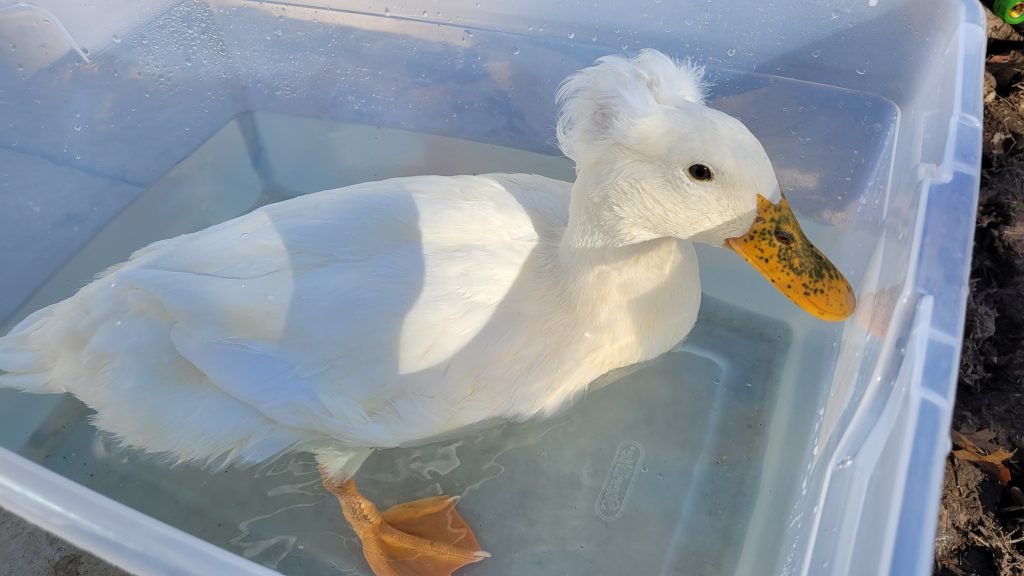
Water Access:
Allowing the ducks access to a shallow pool or water source can help them during the egg-laying process. Ducks may instinctively seek water when they need to lay eggs, as the buoyancy and support provided by the water can help ease the passage of the egg through the reproductive tract. Ensure the water level is shallow enough for the ducks to comfortably stand or float in, and monitor them closely to ensure their safety. Providing access to water can help reduce stress and discomfort for the ducks during the egg-laying process.
Gentle Massage:
Gently massage the duck’s abdomen to help stimulate contractions and facilitate egg movement through the reproductive tract. Use gentle, circular motions and avoid applying excessive pressure to prevent injury. In many cases, this leads to a successful egg passing. However, you need to be very careful because this could cause the egg inside to break, which is life-threatening. It’s always best to have the vet take care of it if in doubt.
If it breaks, you will have to remove all the shells manually. Any shell pieces left inside will cut and abrasion the interior of the oviduct, leaving your duck prone to infection. If the egg broke inside her, you would need to give her some antibiotics to prevent infection—this requires a veterinarian.
Let’s Summarize the Key Points:
In summary, addressing soft-shelled eggs in ducks requires a multifaceted approach that encompasses various factors, including nutrition, environment, and health management. By understanding the potential causes of soft-shelled eggs, such as nutritional deficiencies, hormonal imbalances, and stress, duck enthusiasts can implement proactive measures to support eggshell formation and overall reproductive health in their flock.
Key strategies for preventing and treating soft-shelled eggs include providing a balanced diet rich in calcium, phosphorus, and vitamin D, offering supplemental sources of calcium like crushed oyster shells, creating a stress-free environment for ducks, and seeking veterinary guidance when needed. Additionally, supporting ducks during the egg-laying process with warm water baths or access to water can help alleviate discomfort and facilitate egg passage.
By combining nutritional management, environmental adjustments, and attentive care, duck enthusiasts can effectively manage soft-shelled eggs and promote the health and well-being of their flock. Prioritizing the specific needs of each duck and addressing any underlying issues contributing to soft-shelled eggs can lead to a happier, healthier flock and ensure a successful egg-laying experience for all.
Related Posts:
- Breaking Down Egg Binding in Ducks: What Every Duck Keeper Should Know
- How We Saved Our Egg-Bound Duck Schnatterinchen (Case Study)
- How We Treated Our Egg-Bound Duck Penny (Case Study)
- Hormone Implants for Ducks: Leuprolide Acetate and Deslorelin Acetate
- 29 Must-have Items for Your Pet Duck First Aid Kit
- Duck Egg Production: How Often Do Ducks Lay Eggs?
- No Eggs from Your Ducks? Discover 7 Reasons Why
- 15 Common Duck Health Conditions You Should Know About
- What Do Ducks Eat? Your Guide To Feeding Ducks


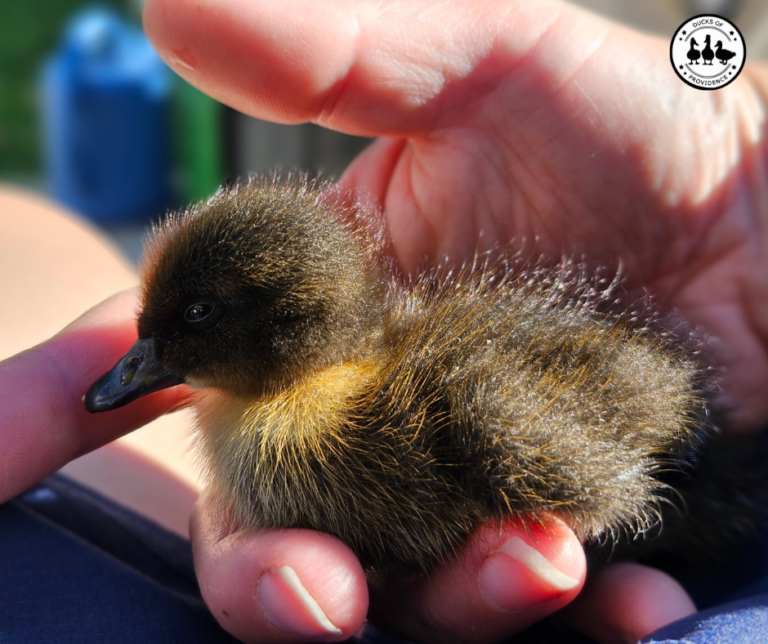

I could not understand what you said — music in background, your voice too low & words running together.A shame because I needed help for my Millie duck.
I am sorry about that. I believe you are talking about the linked YouTube video? This post has also all the information (and more) covered. So I hope you find useful information to help your duck Millie.
Hi, that was a very interesting and detailed read indeed. Thanks for posting it.
We have a soft shelled egg problem with only one of a small flock of 3 khaki campbell ducks.
They are all about the same age, all eat the same food and all free range for many hours almost every day.
They have a pond in their pen, and a winter creek with a pond when they are out during the day.
When they are out they have access to a lot of edible plant material, and 2ac. of insect rich foraging landscape.
We have tried making extra calcium available, but nothing worked.
After reading your article it seems pretty likely that it is either genetics or hormonal, neither of which we can do much about, but at least we have a likely answer.
Thanks again.
Phill
Khaki campbell ducks are known to have reproductive issues. We have one Khaki ourselves (Krümel), and she had problems as well. A blood test revealed that her calcium and phosphorus levels were fine. But she had a metal poisoning, most likely responsible for the egg problems. You could get your ducks blood tested to be sure.
Thanks for the reply Melanie, but veterinary costs in Australia are not cost effective for anything less than life threatening or life changing issues. She is happy enough, and we get more eggs than required. 🙂
I don’t blame you. Vets are also quite expensive here, especially for exotic pets like ducks. Just wanted to throw that in as a possibility.
This article is an excellent resource! It’s packed
with insightful and useful info, especially for those of us
who are dedicated to improving our overall health.
I love how you break down difficult ideas into easy-to-apply suggestions
that’s easy to follow. I’ll definitely be sharing this on my blog about diets and
nutrition, as I’m sure my readers will find your insights as valuable
as I did. Thanks for putting together such
a great piece!